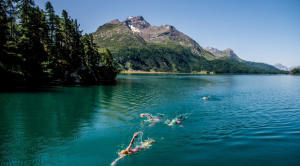In the early days of SwimRun events, participants modified standard triathlon wetsuits so they could be used for hours of swimming and running over a variety of terrain, but now there are specific SwimRun suits made for the sport like this HUUB Amphibia. Our experienced Markus Rössel takes a closer look at this British entry a few days before the 10th anniversary of the ÖtillÖ SwimRun World Championships in Sweden.
Swimming with shoes and running in your altered wetsuit is something that wasn’t seen or done until recently, and athletes still trim well know triathlon wetsuits to suit their needs by cutting sleeves or legs of the full body suits. Subsequently more and more companies have turned their attention towards the specific needs of this sport. It was Italian brand HEAD, as well as Austrian neoprene manufacturer Camaro, that came up with the first SwimRun specific suits. Following the success of their Archimedes wetsuit, HUUB got feedback from some of their SwimRun athletes to generate their first SwimRun-only suit, the Amphibia.
The Derby based wetsuit experts based the design of their first SwimRun specific suit on the Archimedes 3:5, transferring the top-notch arm flexibility and additional buoyancy to the lower body section of the suit. Modifications made to adapt to the requirements of the SwimRunner include: an easy to use front zipper (essential on longer runs), the standard “bottom-up” closing back zipper, three easy to use inside pouches for gels and other gear, plus more robust materials on the legs and hips.
The Amphibia is a strong yet flexible piece of work in itself. All seams inside the arms and legs are already sealed from the bottom to above knees and elbows. It is no longer compulsory to glue the seams of the suit after cutting to avoid loose threads. However, taking some time to find the dimensions that suit you the best does pay off. Leaving arms and legs too long can lead to painful blisters and overheating on the run. But if you cut the suit too short, you lose a lot of flotation and low water temperatures might become a problem. And the hot pants look is not hip at the moment anyway.
Once the suit is cut, you cannot go back, so make sure you cut the arms and legs long on the first try and then take away more material in small increments if necessary. You will have to put the suit on and take it off a couple of times, but it’s the only way if you want a perfect fit.
This being said, you need to make sure to choose your size wisely. While cutting the arms, a comparably loose fit around the upper part of the sleeves was noticed. This might be due to the absence of proper "guns," but we are all endurance athletes rather than bodybuilders.
HUUB is widely known for triathlon wetsuits and the Amphibia is their first SwimRun specific product.

SwimRun suits need to be cut. The Amphibia offers pre-sealed seams which do not need to be glued after the arms and legs are cut to a custom length.

The X-O Skeleton shape with NRB Composite distributes improved buoyancy and therefore better body alignment. This can be essential when swimming with shoes.

In addition to the typical back zipper, an additional front zip offers the racer an easy way to cool the body during longer run sections.

Even with the extra buoyancy, the suit still has great upper body flexibility.

Two easy-to-use inside compartments on the front of the suit offer space for gels.

It is exciting to see how the industry responds to the needs and requirements of new sports!

After putting the Amphibia through some rough training and racing, there are a few things to highlight apart from a favorable overall impression.
First of all, adding extra padding and nylon material at spots where there is a lot of abrasion really pays off. While SwimRun athletes encountered serious wear and tear at highly exposed areas, such as the inside of the quads, when using standard triathlon wetsuits, this issue has been solved. This being said, the strong and durable materials do reduce flexibility a bit. Cutting the legs above the knees, though, mostly takes care of this. As mentioned above, the upper sleeves are cut slightly too wide for some runners' chicken arms and some water may enter around the arms. As water temperatures are usually quite cold at SwimRun races, this might be a little inconvenient. But on the upside, it won't add drag or slow you down too much.
The most obvious advantage is the front zipper. It is designed bottom-up and seems very durable. Using it is straightforward and provides extra breathing space and flexibility, especially necessary during longer run sections like the infamous 20k run on Ornö during the later stages of ÖTillÖ. From the flap-less V-neck look of the suit, one might be suspicious about potential water entry around the neck, but it was not an issue. It will be interesting to see whether the industry will get rid of the back zippers altogether in the future.
We are excited to see what the wetsuit market will have to offer for the future of SwimRun adventures. Stay tuned to this gem of the web to stay up-to-date with all the action.
The Amphibia retails for £399.99 and it comes in sizes XS, S, M, ML, L and XL. It mostly is sold in Northern Europe where the bulk of SwimRun races take place.
All images © Markus Rössel /slowtwitch.com



